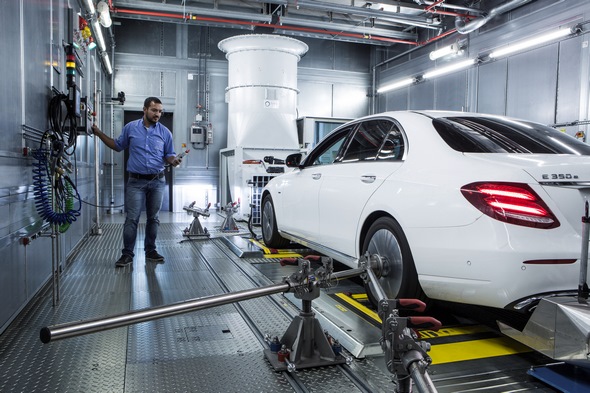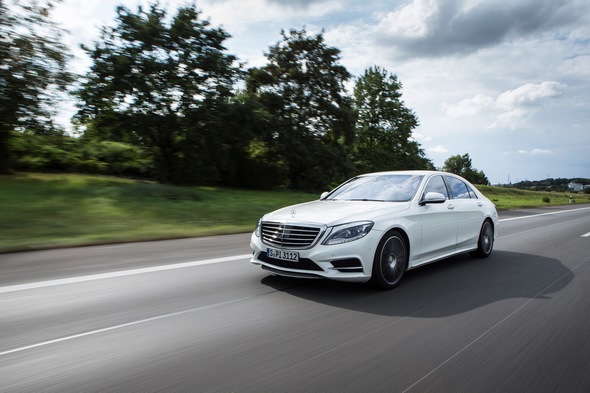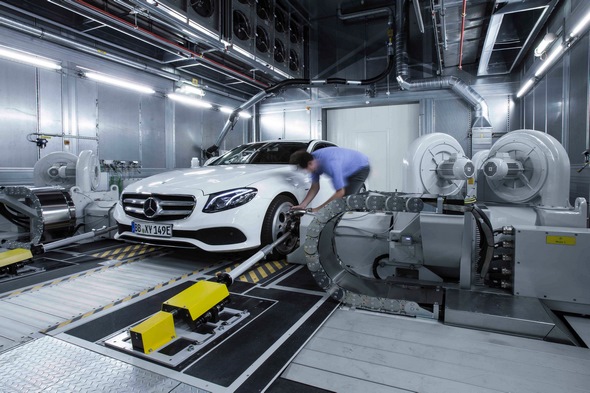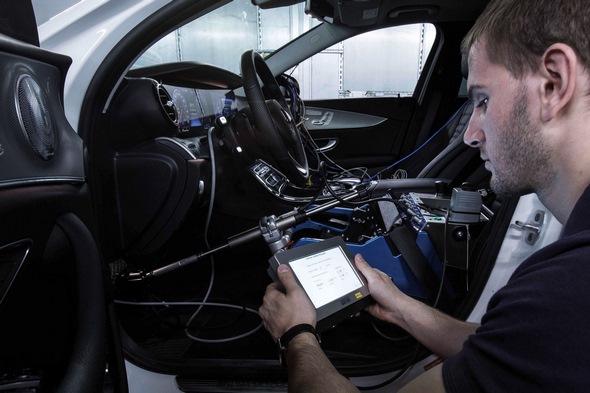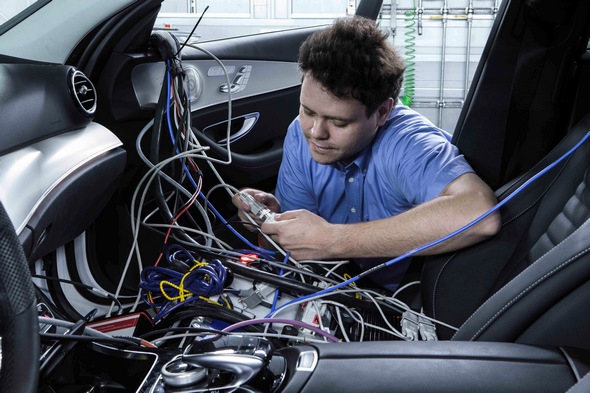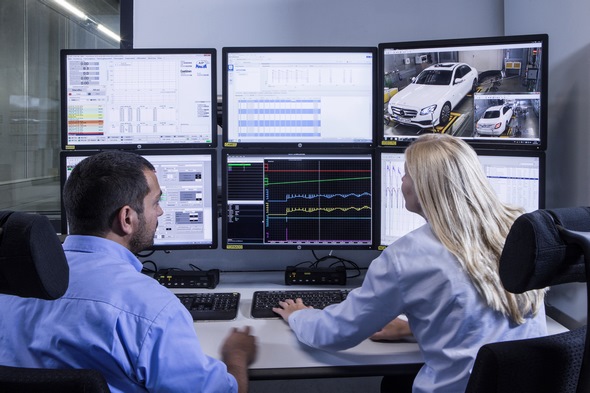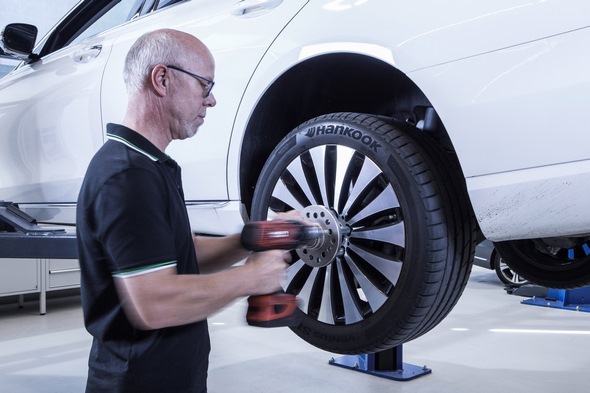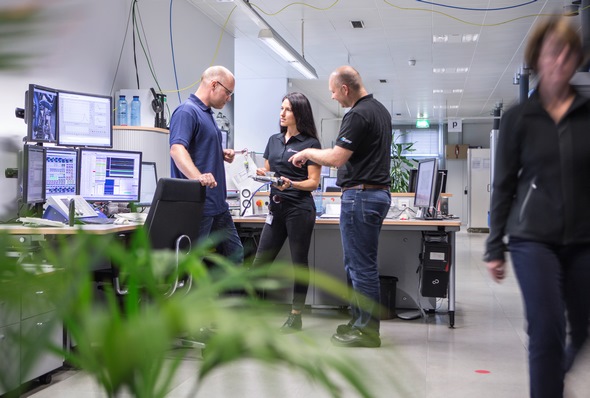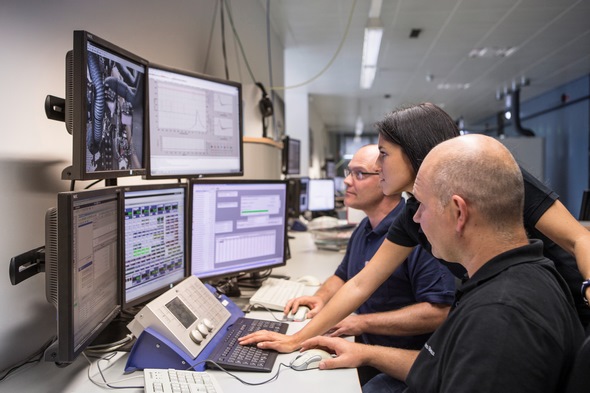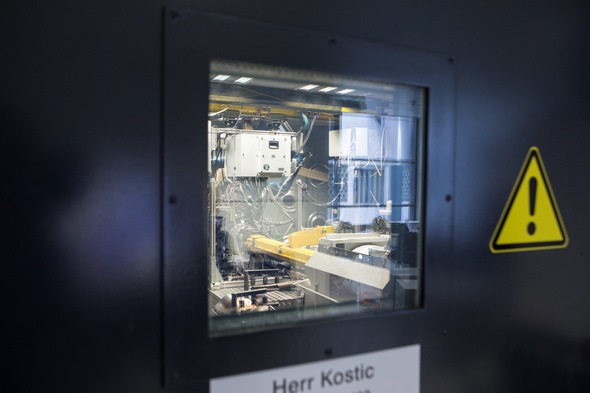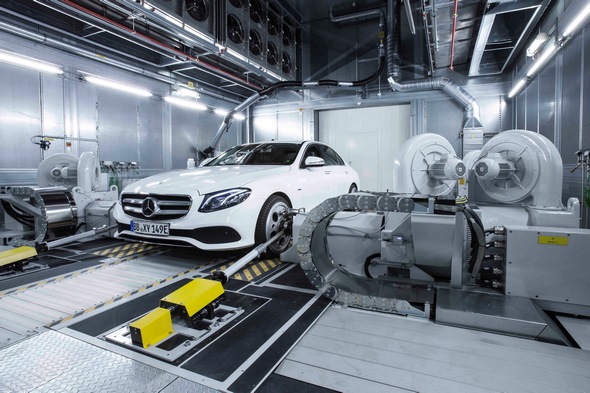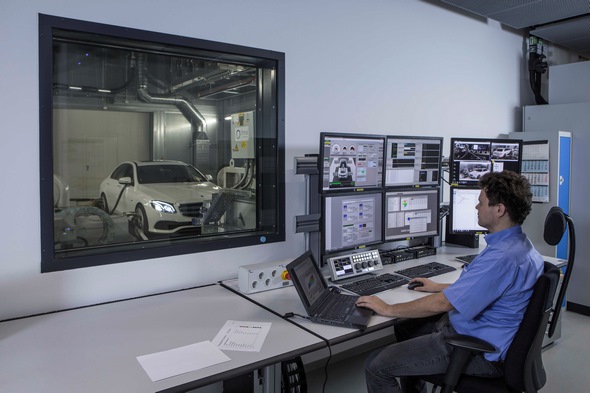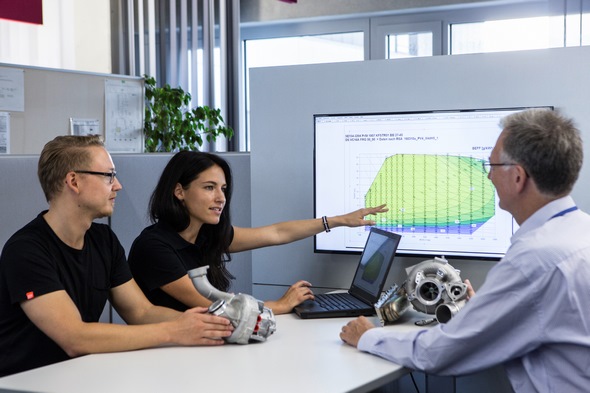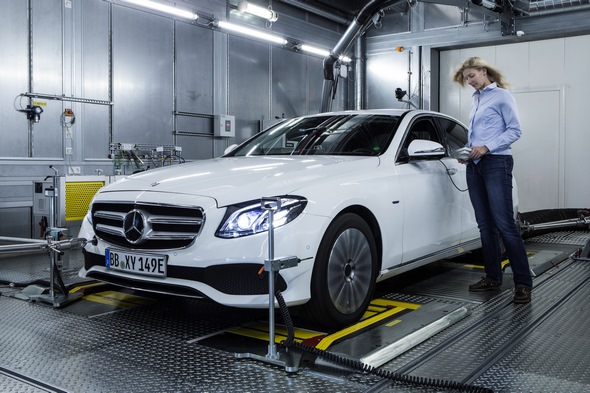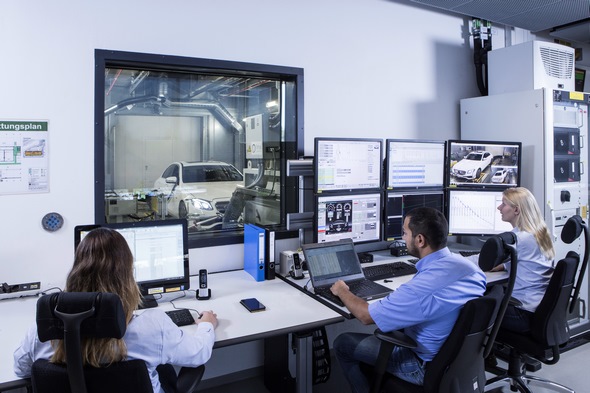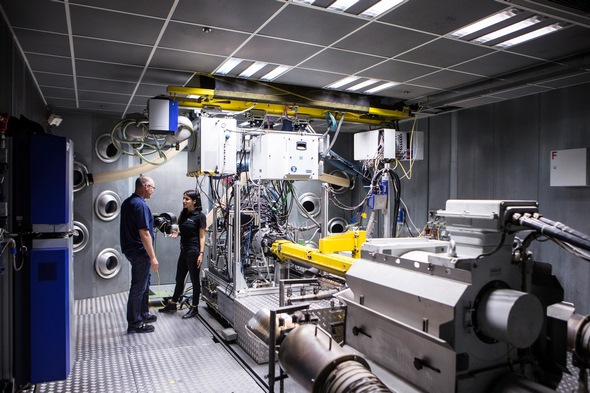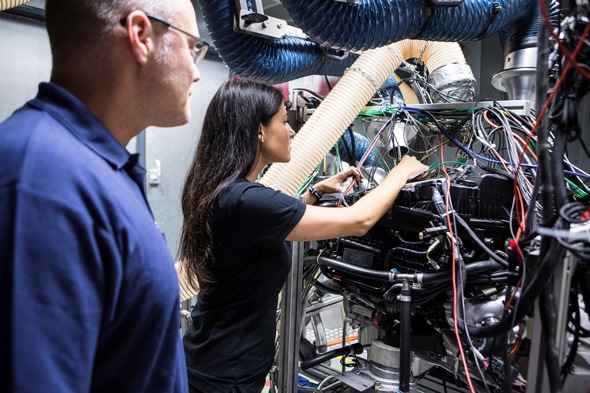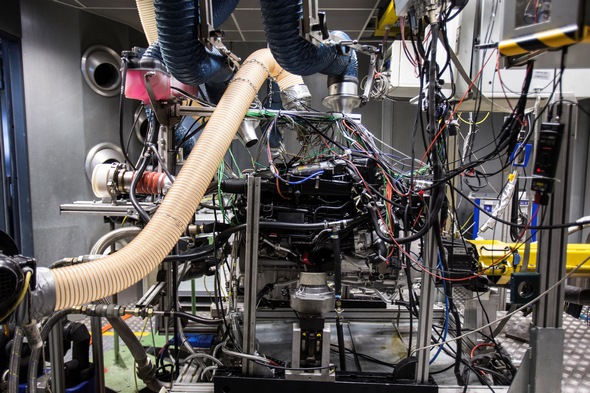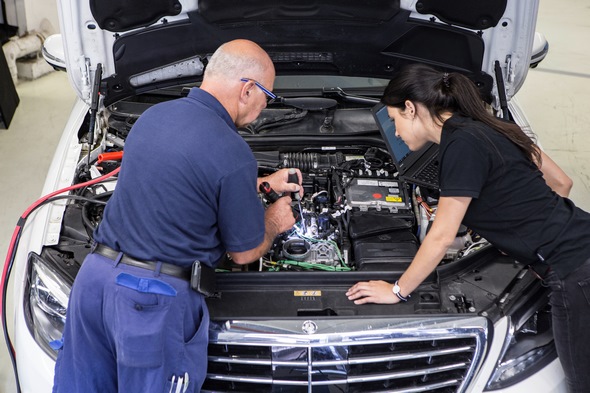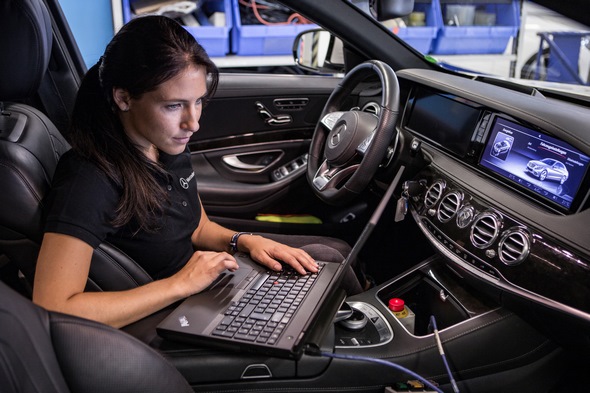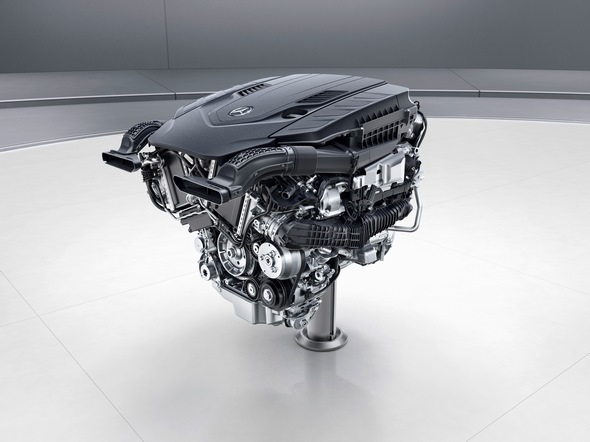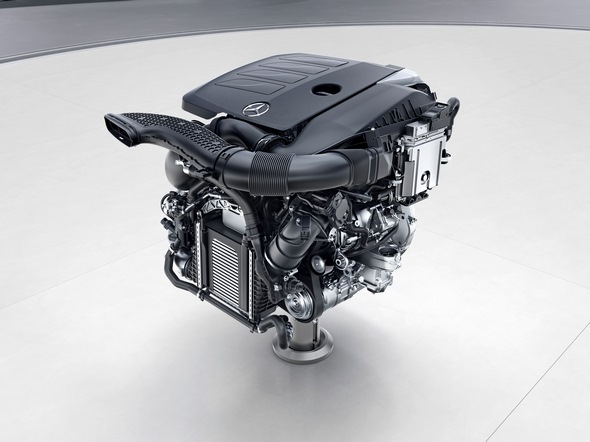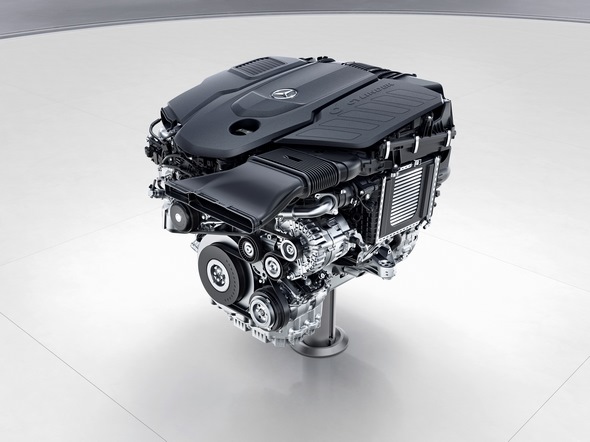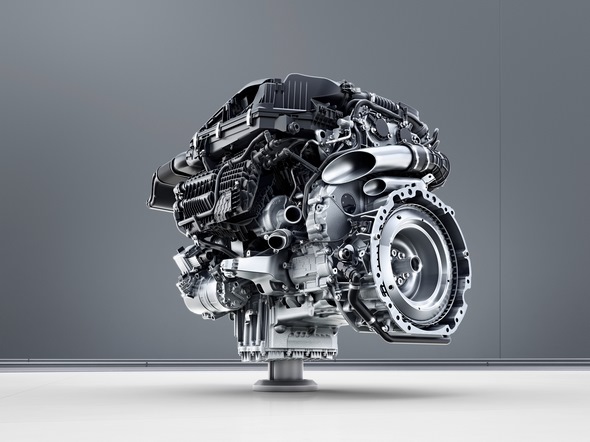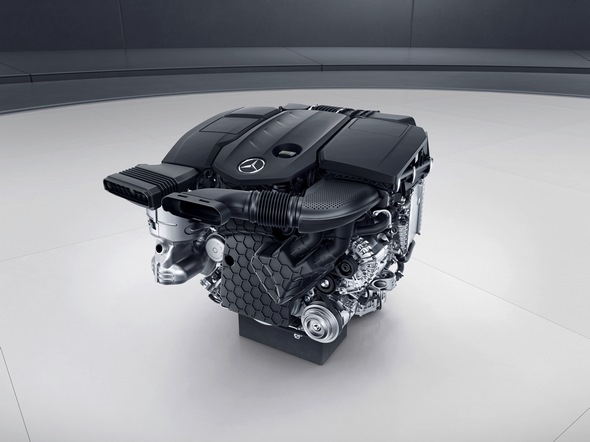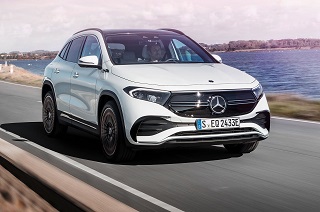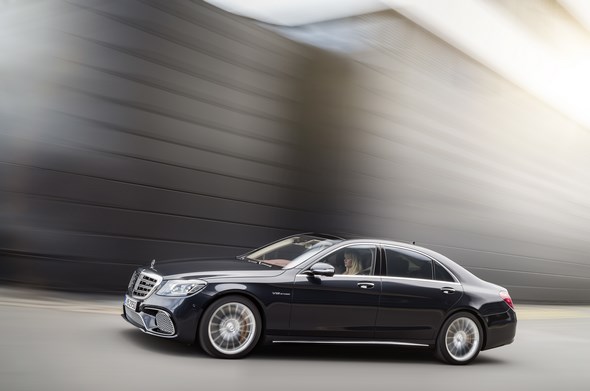Extensive strategic engine initiative from Mercedes-Benz

More powerful, more economical and cleaner
Stuttgart/Sindelfingen. The biggest strategic engine initiative in the history of Mercedes-Benz will enter its decisive phase in 2017.
Following the launch of the new four-cylinder diesel engine in spring 2016, next year will see the addition of no fewer than four more members to the all-new family of engines: six-cylinder in-line engines in both diesel and petrol versions, a new four-cylinder petrol engine and a new biturbo V8.
At the same time, there will be world premieres for ground-breaking technologies, such as the Integrated Starter-Alternator (ISG), the 48 V electrical system and the electric auxiliary compressor (eZV).
These new technologies are tuned to the vehicles on state-of-the-art test rigs at the equally new Powertrain Integration Centre (AIZ) in Sindelfingen.
“More powerful, more economical and cleaner – the new modular family of engines from Mercedes-Benz offers the right powertrain for every vehicle,” says Prof. Dr Thomas Weber, 62, Member of the Daimler Board of Management with responsibility for Group Research at Daimler AG and Mercedes-Benz Cars Development.
“The systematic optimisation of our high-tech engines plays a crucial role in the road map towards sustainable mobility. They also need to be designed with a view to all current and future requirements. A key success factor in this regard is the extensive electrification of the powertrain.”
Systematic electrification: new six-cylinder in-line petrol engine M 256
The new six-cylinder in-line petrol engine M 256 represents an outstanding example of electrification, including a 48 V electrical system. New, intelligent turbocharging, e.g. with an electric auxiliary compressor (eZV), as well as an Integrated Starter-Alternator (ISG) provide the guarantee of excellent drivability with no turbo lag.
The ISG is responsible for hybrid functions, such as boost or energy recovery, while allowing fuel savings that were previously reserved for high-voltage hybrid technology.
The bottom line is that the new six-cylinder in-line engine offers the same performance as an eight-cylinder machine while being much more fuel-efficient.
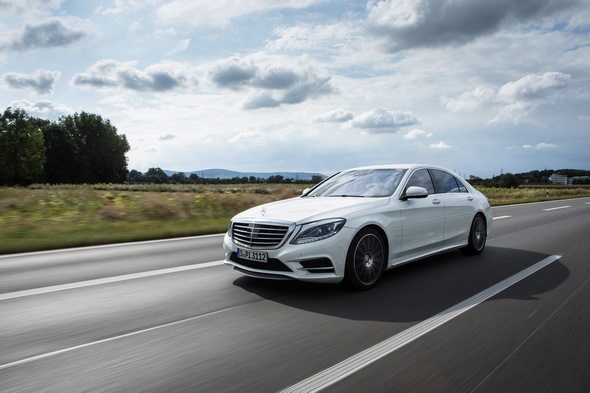
The new petrol engine (internal code: M 256) launches next year in the new S-Class.
Systematic electrification dispenses with the need for a belt drive for ancillary components at the front of the engine, which reduces its overall length.
The narrow construction, together with the physical separation of intake/exhaust, creates space for near-engine exhaust aftertreatment. The 48 V electrical system serves not only high power consumers, such as the water pump and air-conditioning compressor, but also the Integrated Starter-Alternator (ISG), which also supplies energy to the battery by means of highly efficient energy recovery.
An additional bonus is the unsurpassed refinement of the six-cylinder in-line engine. Output and torque are similar to the current eight-cylinder engine, i.e. over 300 kW (408 hp) and more than 500 Nm. In comparison with the previous V6, the CO2 emissions from the engine have been reduced by around 15 percent.
At 500 cc, the new machine has the same displacement per cylinder as the premium diesel engine family unveiled last year as well as the family of four-cylinder petrol engines.
Most powerful passenger-car diesel engine in the history ofMercedes-Benz: six-cylinder OM 656
The new top-of-the-line engine in the premium diesel family is likewise a six-cylinder in-line machine. The characteristics of the OM 656 include the stepped-bowl combustion process, two-stage exhaust turbocharging and, for the first time, the use of CAMTRONIC variable valve timing.
Its design features a combination of aluminium engine block and steel pistons as well as further-improved NANOSLIDE® coating of the cylinder walls. Although there is a significant increase in output compared with the previous OM 642 (over 230 kW/313 hp instead of
190 kW/258 hp), the new engine consumes more than seven percent less fuel.
Like the already unveiled four-cylinder OM654, the new six-cylinder diesel engine OM 656 is likewise designed to comply with future emissions legislation (RDE – Real Driving Emissions).
All the components of relevance for efficient emissions reduction are installed directly on the engine. The integrated technology approach of new stepped-bowl combustion process, dynamic multi-way exhaust gas recirculation and near-engine exhaust aftertreatment, combined for the first time with variable valve timing, opens the way for further reductions in consumption together with extremely low emissions.
Thanks to the near-engine insulated configuration, exhaust aftertreatment has a low heat loss and extremely favourable operating conditions. This is reinforced by the CAMTRONIC switchable exhaust camshaft, which supports the consumption-neutral heating of the exhaust system.
Number of cylinders to suit the requirements: new V8 biturbo petrol engine M 176
Dynamic power delivery combined with high efficiency: the new biturbo (internal code: M 176) is one of the most economical V8 petrol engines in the world.
Its special features include cylinder shutoff at part load as well as the positioning of the turbochargers in the V between the cylinder banks.
From its 3982 cc displacement, the new V8 biturbo produces over 350 kW (476 hp) with a maximum torque of around 700 Nm from 2000 rpm. The new engine will consume over 10 percent less fuel than its predecessor, which is rated at 335 kW (455 hp). The new V8 will launch with this technology next year in the new S-Class.
For lower fuel consumption, when operated at part load the new M 176 shuts off four cylinders simultaneously by means of CAMTRONIC valve timing. This reduces the pumping losses while improving the overall efficiency of the remaining four cylinders by shifting the operating point towards higher loads.
Sporty specific output: new four-cylinder petrol engine M 264
A two-litre four-cylinder engine with a specific output of around 100 kW: the new Toptype petrol engine from Mercedes-Benz (internal code: M 264) advances into output regions previously reserved for high-displacement six-cylinder machines.
At the same time, it consumes significantly less fuel than a comparable six-cylinder engine. The engine’s special features include twin-scroll turbochargers, belt-driven 48 V starter-alternator (BSA) and electric 48 V water pump.
The BSA is also responsible for fuel-saving hybrid functions:
Easy start: virtually imperceptible starting and acceleration of the engine
Boost in the engine-speed range up to 2500 rpm
Energy recovery up to 12.5 kW
Shifting of the load point: allows operation in a more favourable area of the engine map
Coasting with engine off.
In the interests of high power output and a spontaneous engine response, Mercedes-Benz has opted for twin-scroll turbocharging. Unlike conventional systems, a twin-scroll turbocharger merges the exhaust gas ducts of cylinder pairs in the flow-optimised manifold.
This turbocharging concept with systematic cylinder flow separation produces high torque in the low-rpm range together with high specific output. Further efficiency measures include intake CAMTRONIC and a friction loss reduction package.
Even cleaner: particulate filter for petrol engines as standard
Mercedes-Benz is the first manufacturer to opt for the large-scale use of particulate filters for petrol engines to further improve their environmental compatibility.
After more than two years of positive experience in the field with the S 500, in 2017 further S-Class variants will be equipped with the new M 256 and M 176 petrol engines with this technology.
The filter will then be gradually introduced in other new vehicle models, facelifted models and new engine generations, such as the
M 264.
The particulate filter for petrol engines reduces the emissions of fine soot particles. How it works: the exhaust-gas stream is supplied to a particulate filter system.
The filter has a honeycomb structure with alternately sealed inlet and outlet channels. This forces the exhaust gas to flow through a porous filter wall, which traps the soot. The filter can be continuously regenerated under corresponding driving conditions.
New Powertrain Integration Centre (AIZ): state-of-the-art test rigs
With its new Powertrain Integration Centre (AIZ), in summer 2016 Mercedes-Benz took into service one of the automotive industry’s most advanced test facilities.
A total of ten vehicle test rigs inside the all-new state-of-the-art building in Sindelfingen are used for such purposes as the fine tuning of engine and transmission – comfort, dynamics and agility are matched to each other.
The highlights include test rigs with high-precision torque measurement directly at the wheels of the vehicle as well as a test rig with a climatic altitude chamber, which uses partial vacuum to simulate an altitude of up to 5000 metres at temperatures of down to -30°C, while the vehicle operates fully automatically on a chassis dynamometer.
The new building at the Sindelfingen Mercedes-Benz Technology Centre (MTC) houses ten vehicle test rigs for tuning vehicles and their powertrains.
The new building used 16,800 m3 of concrete, equivalent to the capacity of five Olympic swimming pools. There were also 2500 tonnes of reinforcing steel.
The designers of the AIZ attached great importance to energy recovery, with 98 percent of the electric braking energy produced on the test rigs being fed back into the power network.
Also, the air conditioning of the test rigs is energy-neutral for two-thirds of the year, which means that no power is consumed from the joint network. With all ten test rigs in continuous operation, this would be the same as supplying around 7500 households with electricity.
Extension of the Mercedes-Benz Technology Centre
The new Powertrain Integration Centre is part of extensive additions and conversions to the Mercedes-Benz Technology Centre (MTC) in Sindelfingen.
The new driving simulator, climatic wind tunnels and a high-tech aero-acoustic wind tunnel are already in operation. By 2018, there will also be a state-of-the-art technology centre for vehicle safety, an electronics testing centre and a computer centre.
Housed on the upper floor of the AIZ, the computer centre will directly use the electricity generated downstairs on the test rigs in order to operate and cool the computers.
The MTC is home to the headquarters of the company’s global Group Research and passenger car development, including design.
The new generation of engines from Mercedes-Benz
The highlights
More powerful, more economical and cleaner: the new modular engine family from Mercedes-Benz
The new engine family from Mercedes-Benz sets new standards in terms of power output, refinement and efficiency.
The new family of petrol and diesel engines, with 4, 6 and 8 cylinders, is of modular design. The key features of the new family are a standard cylinder spacing of 90 mm and identical interfaces to the vehicle, which makes for modern, flexible production, among other things.
The scaling of state-of-the-art technologies and electrification options from 12 V to 48 V to high-voltage plug-in applications makes it possible to configure the appropriate powertrain for every vehicle.
Mercedes-Benz is investing a total of around 3 billion euros in its strategic engine initiative.
The new family of engines was launched in 2016 with the four-cylinder diesel OM 654 and will be systematically extended with the following engines in 2017:
six-cylinder in-line petrol engine M 256
four-cylinder in-line petrol engine M 264
V8 petrol engine M 176
six-cylinder in-line diesel engine OM 656
A host of innovations will go into series production in 2017:
electric auxiliary compressor eZV
Integrated Starter-Alternator ISG
belt-driven starter-alternator BSA
48 V electrical system
cylinder shutoff
Particulate filters for petrol engines
near-engine exhaust system
2500 bar diesel injection
CAMTRONIC in diesel engine (OM 656), V8 biturbo petrol engine (M 176) and four-cylinder petrol engine (M 264)
In 2017, the new S-Class will be the first Mercedes-Benz vehicle to be powered by the new engines.
The new engines are tuned to the vehicles on state-of-the-art test rigs at the new Powertrain Integration Centre (AIZ) in Sindelfingen, where new technologies and powertrains are continuously further developed for the future.
New six-cylinder petrol engine (M 256)
Fascinating 48 V drive
Mercedes-Benz has developed a new six-cylinder in-line petrol engine that has for the first time been systematically designed for electrification.
New, intelligent turbocharging, e.g. with an electric auxiliary compressor (eZV), as well as an Integrated Starter-Alternator (ISG) provide the guarantee of excellent drivability with no turbo lag. ISG is responsible for hybrid functions, such as boost or energy recovery, while allowing fuel savings that were previously reserved for high-voltage hybrid technology.
The bottom line is that the new six-cylinder in-line engine offers the same performance as an eight-cylinder machine while being much more fuel-efficient. The new petrol engine (internal code: M 256) launches next year in the new S-Class.
The six-cylinder in-line engine features systematic electrification. For example, there is no belt drive for ancillary components at the front of the engine, which reduces its overall length.
The narrow construction, together with the physical separation of intake/exhaust, creates space for near-engine exhaust aftertreatment. At 500 cc, the new engine has the same displacement per cylinder as the premium diesel engine family unveiled last year as well as the family of four-cylinder petrol engines.
An additional bonus is the unsurpassed refinement of the six-cylinder in-line engine.
The output and torque of the new six-cylinder in-line engine are similar to the current eight-cylinder machine, i.e. over 300 kW (408 hp) and more than 500 Nm.
In comparison with the previous V6, the CO2 emissions from the engine have been reduced by around 15 percent.
Its performance is as dynamic as that of a V8, as the new six-cylinder in-line engine comes with an especially intelligent form of turbocharging: assisted by the ISG at start-off, the electric auxiliary compressor (eZV) guarantees immediate high torque when driving off and accelerating, bridging the time before the large exhaust turbocharger cuts in.
The electric turbocharger accelerates to 70,000 rpm within 300 milliseconds, ensuring an extremely spontaneous reaction from the engine. The result is a dynamic engine response with no turbo lag.
The M 256 is the first member of a new family of premium petrol engines that have for the first time been systematically designed for electrification from the outset.
The 48 V electrical system serves not only high power consumers, such as the water pump and air-conditioning compressor, but also the Integrated Starter-Alternator (ISG), which also supplies energy to the battery by means of highly efficient energy recovery.
The ISG dispenses with the need for a belt drive for these components. This not only reduces the overall length of the engine and its complexity, but also paves the way for new, efficient control possibilities. The still existing 12 V system supplies power to consumers such as lights, cockpit, infotainment and control units.
The ISG is a key component of the 48 V system and not only serves as an alternator, but is also responsible for hybrid functions. This allows fuel savings that were previously reserved for high-voltage hybrid technology. For the first time, the ISG is also responsible for idle speed control.
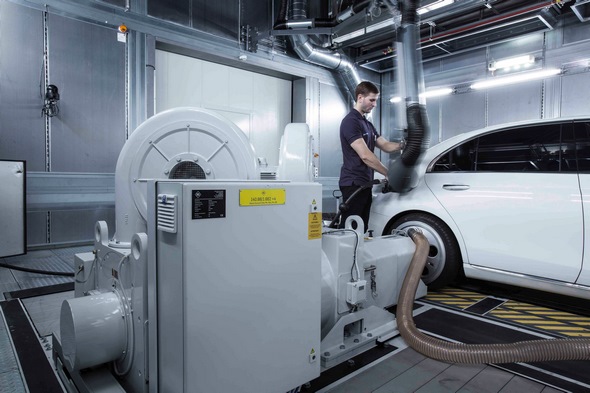
The hybrid functions include:
Boost: 15 kW/220 N
Energy recovery
Shifting of the load point: the engine can be operated in a more favourable area of the engine map; load increase/reduction depending on the state of charge of the battery
Coasting
3S start: almost imperceptible reinstatement of the engine
Another feature of the new family of premium petrol engines is near-engine exhaust aftertreatment. The as-standard particulate filter is the only part of the exhaust system that is under the floor. The M 256 is produced at the Untertürkheim plant.
The data of the new engine in comparison with its predecessor:
Engine M 256 M 276
No. of cylinders/arrangement 6/in-line 6/V
Displacement per cylinder cc 500 499
Displacement cc 2999 2996
Cylinder spacing mm 90 106
Bore mm 83 88
Stroke mm 92.4 82.1
Bore/stroke 1.11 0.93
Connecting rod length mm 140.5 148.5
Rated output kW/hp over 300/408 245/333
Peak torque Nm over 500 480
Compression ratio 1: 10.5 10.5
New V8 biturbo petrol engine (M 176)
Number of cylinders to suit the requirements
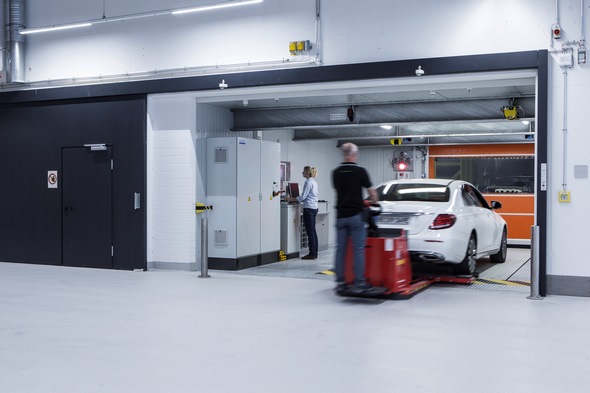
Dynamic power delivery combined with high efficiency: the new biturbo is one of the most economical V8 petrol engines in the world. The special features of the V8 (internal code: M 176) include cylinder shutoff at part load. The M 176 will launch with this technology next year in the new S-Class.
Developed by AMG for Mercedes-Benz, the hallmarks of the new V8 biturbo are exemplary efficiency and environmental compatibility as well as superlative performance.
From its 3982 cc displacement, the new V8 biturbo produces over 350 kW (476 hp) with a maximum torque of around 700 Nm from 2000 rpm. The new engine will consume over 10 percent less fuel than its predecessor, which is rated at 335 kW (455 hp).
For even lower fuel consumption, when operated at part load the new M 176 shuts off four cylinders simultaneously by means of CAMTRONIC valve timing. This reduces the pumping losses while improving the overall efficiency of the remaining four cylinders by shifting the operating point towards higher loads.
The cylinders are turned on and off by the interplay between engine control and actuators on the cylinder head. The switchover to four-cylinder operation is accomplished by eight actuators that act on the axially movable cam parts of the intake and exhaust camshafts via a selector.
These cam parts are held on the carrier shaft by gears and are locked in the respective end positions by means of a locking mechanism. The intake and exhaust valves of cylinders 2, 3, 5 and 8 do not open due to the zero-lift cams of the cam parts.
At the same time, the fuel supply and ignition are deactivated, so that no unburned mixture is left in the deactivated combustion chamber.
Cylinder shutoff is active in the engine-speed range between 900 and 3250 rpm, provided the driver has selected mode C or E with the DYNAMIC SELECT switch.
Cylinder shutoff is inactive in all other transmission modes. As soon as the driver requests higher engine power via the position of the accelerator or as soon as the engine speed goes above 3250 rpm, cylinders 2, 3, 5 and 8 are reinstated within a matter of milliseconds.
The transition between the two operating modes is seamless and with no loss of comfort for the occupants. The main menu in the instrument cluster shows whether the engine is currently in four- or eight-cylinder mode.
The new V8 biturbo employs a centrifugal pendulum to reduce both the fourth-order vibrations in eight-cylinder mode as well as the second-order vibrations in four-cylinder mode.
A combination of biturbocharging and direct petrol injection with spray-guided combustion increases the thermodynamic efficiency, thereby reducing the fuel consumption and exhaust emissions.
Particularly fast and precise piezo injectors spray the fuel at high pressure into the eight combustion chambers. Multiple injection occurs on-demand, ensuring a homogeneous fuel/air mixture. The delivery of fuel is electronically controlled and fully variable for a fuel pressure between 100 and 200 bar.
The engine is of closed-deck construction, which means that the engine block cover plate is extensively closed in the area around the cylinders.
The engine block is of an aluminium alloy and produced by permanent mould casting. This ensures extreme strength while keeping the weight as low as possible, and allows high injection pressures of up to 140 bar.
The further-improved NANOSLIDE® coating of the cylinder liners reduces the friction loss while contributing to excellent efficiency. The cylinder head uses an aluminium-zirconium alloy, which is a better conductor of heat than the standard aluminium alloy.
“Spectacle honing” is another measure for reducing the friction and therefore consumption: in this complex process, the cylinder liners receive their mechanical surface treatment when already bolted in place.
A jig resembling spectacles is bolted to the engine block in place of the cylinder head, which is mounted later. The honing of the engine block already produces the same state of stress as when the cylinder heads are mounted.
For this reason, the tension of the piston rings can be reduced, which leads to a further reduction in friction loss and lower oil consumption.
For an exceptional engine response and low exhaust emissions, the two turbochargers are positioned not on the outside of the cylinder banks, but between them in the “V” – experts call this the “hot inside V”.
In the interests of thermal protection for the engine components, the manifolds and exhaust turbochargers are specially insulated.
The efficiency-raising measures include the low-friction drive of alternator and refrigerant compressor by means of two short four-groove belts. The water pump is chain-driven by the timing assembly. A two-stage feedback-controlled oil pump circulates the engine oil. It varies the flow rate depending on the required load and engine speed, thereby helping to save fuel.
The M 176 has exhaust aftertreatment with two catalysts directly mounted on the engine and on the underfloor. The as-standard particulate filter is part of the exhaust system under the floor.
The M 176 is produced at the Untertürkheim plant in Stuttgart.
The data of the new engine in comparison with its predecessor:
Engine M 176 M 278
No. of cylinders/arrangement 8/V 8/V
Displacement per cylinder cc 498 583
Displacement cc 3982 4663
Cylinder spacing mm 90 106
Bore mm 92 92.9
Stroke mm 83 86
Bore/stroke 1.1 0.92
Rated output kW/hp over 350/476 335/455
Peak torque Nm approx. 700 700
Compression ratio 1: 10.5 10.5
Emissions standard EU 6 EU 6
New six-cylinder diesel engine (OM 656)
Majestic long-distance athlete
With the new six-cylinder in-line diesel engine OM 656, the next member of the ground-breaking family of premium diesel engines from Mercedes-Benz will follow in 2017. Its features include the stepped-bowl combustion process, a combination of aluminium engine block and steel pistons as well as further-improved NANOSLIDE® cylinder wall coating.
The new family of premium diesel engines from Mercedes-Benz celebrated its world premiere with the four-cylinder E 220 d in spring 2016. In 2017, another important representative of this modular family will follow with the six-cylinder in-line engine OM 656.
Although there is a significant increase in output compared with the previous OM 642 (over 230 kW/313 hp instead of 190 kW/258 hp), the new engine consumes more than seven percent less fuel.
A special feature of the family of premium diesel engines is the combination of steel pistons with an all-aluminium engine block. The lower expansion of steel as operating temperatures rise ensures an increasing clearance between piston and aluminium block, thereby reducing the friction by 40 to 50 percent.
At the same time, the fact that steel is stronger than aluminium allows very compact, lightweight pistons that even offer additional strength reserves. Finally, the lower thermal conductivity of steel leads to higher component temperatures, thereby improving the thermodynamic efficiency, increasing combustibility and reducing combustion duration.
The combination of innovative steel pistons and the optimised piston ring package with the further-improved NANOSLIDE® coating of the cylinder walls results in benefits in terms of fuel consumption and CO2 emissions, especially in the lower and medium engine-speed ranges, which are of relevance for day-to-day vehicle use.
Stepped-bowl combustion process
The new OM 656, too, employs the Mercedes-Benz stepped-bowl combustion process – named after the shape of the combustion bowl in the piston.
The stepped bowl has a positive effect on the combustion process, the thermal loading of critical areas of the pistons and the introduction of soot into the engine oil.
The efficiency is increased by the higher burning rate in comparison with the previous omega combustion bowl. The characteristic feature of the specifically configured combination of bowl shape, air movement and injector is its very efficient utilisation of air, which allows operation with very high air surplus. This means that particulate emissions can be reduced to an especially low level.
Exhaust emissions: all set for the future
The new diesel engine is designed to meet future emissions legislation (RDE – Real Driving Emissions). All the components of relevance for efficient emissions reduction are installed directly on the engine.
Supported by insulation measures and improved catalyst coatings, there is no need for engine temperature management during cold starting or at low load. In addition to the advantages in terms of emissions, this results in fuel savings, especially on short journeys.
Thanks to the near-engine configuration, exhaust aftertreatment has a low heat loss and extremely favourable operating conditions. This is reinforced by the CAMTRONIC switchable exhaust camshaft, which supports the consumption-neutral heating of the exhaust system.
The new engine is equipped with multi-way exhaust gas recirculation (EGR). It combines cooled high-pressure and low-pressure EGR. This makes it possible to significantly further reduce the untreated emissions from the engine across the entire engine map, with the centre of combustion being favourable for fuel economy.
The data of the new engine in comparison with its predecessor:
Engine OM 656 OM 642
No. of cylinders/arrangement 6/in-line 6/V
Valves per cylinder 4 4
Displacement per cylinder cc 488 498
Displacement cc 2927 2987
Cylinder spacing mm 90 106
Bore mm 82 83
Stroke mm 92.4 92
Rated output kW/hp over 230/313 190/258
Peak torque Nm over 650 620
Compression ratio 1: 15.5 15.5
Emissions standard EU 6/RDE EU 6
Four-cylinder diesel engine (OM 654)
More economical and powerful, more lightweight and compact
The new four-cylinder diesel engine OM 654 marked the debut of a ground-breaking family of engines from Mercedes-Benz. It is the first passenger car diesel engine to use the stepped-bowl combustion process – named after the shape of the combustion bowl in the piston.
The innovations also include the combination of aluminium engine block and steel pistons as well as the further-improved NANOSLIDE® coating of the cylinder walls.
The new four-cylinder OM 654 celebrated its world premiere with the 220 d in the new E-Class in spring 2016. Installed in a comparable vehicle, the new engine consumes around 13 percent less fuel than its predecessor.
Alongside optimised airflow on the intake and exhaust sides and the use of fourth-generation common-rail injection with pressures up to 2050 bar, the fuel saving is due to a reduction in internal friction by around 25 percent. This was achieved by flat steel pistons with innovative stepped combustion bowls and long connecting rods extensive measures for friction reduction, such as the NANOSLIDE® coating of the cylinder walls offset of the crank assembly reduced displacement systematic lightweight design Unusual combination: aluminium engine block and steel pistons
At first glance, the combination of an aluminium engine block and steel pistons appears unusual, because steel expands less than aluminium when hot, conducts heat less well and is heavier. This explains why aluminium pistons have been used to date. Yet the Stuttgart engine designers have succeeded in turning these seeming disadvantages into advantages.
For example, the lower expansion of steel as operating temperatures rise ensures increasing clearance between piston and aluminium engine block, reducing friction by 40 to 50 percent.
At the same time, the fact that steel is stronger than aluminium allows very compact, lightweight pistons that even offer additional strength reserves. Finally, the lower thermal conductivity of steel leads to higher component temperatures, thereby improving the thermodynamic efficiency, increasing combustibility and reducing combustion duration.
The combination of innovative steel pistons with the further-improved NANOSLIDE® cylinder wall coating results in a reduction in consumption and CO2 emissions of up to four percent. At lower and medium engine speeds, which play an important part in everyday motoring, the reduction in fuel consumption is even more pronounced.
World premiere in a passenger car: Stepped-bowl combustion process
Making its debut in a passenger-car diesel engine, the new OM 654 employs the Mercedes-Benz stepped-bowl combustion process – named after the shape of the combustion bowl in the piston.
The combustion system has been completely redesigned. The stepped bowl has a positive effect on the combustion process, the thermal loading of critical areas of the pistons and the introduction of soot into the engine oil.
The efficiency is increased by the higher burning rate in comparison with the previous omega combustion bowl. The characteristic feature of the specifically configured combination of bowl shape, air movement and injector is its very efficient utilisation of air, which allows operation with very high air surplus. This means that particulate emissions can be reduced to an especially low level.
Exhaust emissions: all set for the future
The new diesel engine is designed to meet future emissions legislation (RDE – Real Driving Emissions). All the components of relevance for efficient emissions reduction are installed directly on the engine.
Supported by insulation measures and improved catalyst coatings, there is no need for engine temperature management during cold starting or at low load. In addition to the advantages in terms of emissions, this results in fuel savings, especially on short journeys.
Thanks to the near-engine configuration, exhaust aftertreatment has a low heat loss and optimal operating conditions.
The new engine is equipped with multi-way exhaust gas recirculation (EGR). It combines cooled high-pressure and low-pressure EGR. This makes it possible to significantly further reduce the untreated emissions from the engine across the entire engine map, with the centre of combustion being optimised for fuel economy.
The OM 654 is produced at the parent plant in Untertürkheim as well as at the wholly owned Daimler subsidiary MDC Power in Kölleda in Thuringia.
Engine 220 d
OM 654 220 d
Predecessor OM 651
No. of cylinders/arrangement 4/in-line
Valves per cylinder 4
Displacement per cylinder cc 487.5 537
Displacement cc 1950 2143
Cylinder spacing mm 90 94
Bore mm 82 83
Stroke mm 92.3 99
Bore/stroke 1.12 1.193
Connecting rod length mm 140 144
Rated output kW/hp 143/195 125/170
at rpm 3800 3000-4200
Peak torque Nm 400 400
at rpm 1600-2400 1400-2800
Specific output kW/l 72 58.3
Compression ratio 1: 15.5 16.2
Emissions standard EU6 EU6
Engine weight (DIN) kg 168 199
New four-cylinder petrol engine (M 264)
Specific output and agility on a par with a sports car
A two-litre four-cylinder engine with a specific output of up to 100 kW: the new Toptype petrol engine from Mercedes-Benz (internal code: M 264) advances into output regions previously reserved for high-displacement six-cylinder machines.
At the same time, it consumes significantly less fuel than a comparable six-cylinder engine. The engine’s special features include twin-scroll turbochargers and belt-driven 48 V starter-alternator (BSA). The M 264 will celebrate its debut next year.
A specific output of around 100 kW per litre almost puts the M 264 on a par with full-blooded sports car engines. In the interests of high power output and spontaneous engine response, Mercedes-Benz has opted for twin-scroll turbocharging, as in the Mercedes-AMG M 133 engine.
Unlike conventional systems, a twin-scroll turbocharger merges the exhaust gas ducts of cylinder pairs in the flow-optimised manifold. This turbocharging concept with systematic cylinder flow separation produces high torque in the low-rpm range together with high specific output.
A further-improved intake manifold with extremely short air paths and an exceptionally compact compressor housing additionally ensure spontaneous engine response and fast reactions to accelerator pedal movements.
The twin-scroll turbocharger has an electric wastegate actuator, which allows fast changes of the charge-air pressure.
Further efficiency measures include intake CAMTRONIC, a newly developed electric 48 V water pump and a friction loss reduction package.
The M 264 is combined with a 48 V electrical system, which is used for the belt-driven starter-alternator (BSA) and the electric water pump.
The BSA is also responsible for fuel-saving hybrid functions:
Easy start: virtually imperceptible starting and acceleration of the engine
Boost in the engine-speed range up to 2500 rpm
Energy recovery up to 12.5 kW
Shifting of the load point: the engine can be operated in a more favourable area of the engine map; load increase/reduction depending on the state of charge of the battery
Coasting with engine off
iECO: extended stop/start with intelligent engine shutoff even at low speeds
At the very top of the list of requirements for developers were comfort and NVH (noise, vibration, harshness). Plastic engine mounts and the BSA contribute to exemplary refinement, as do numerous insulation measures.
These include insulation of the engine block and extensive covering of the engine with an acoustic insert as well as further NVH optimisation in relation to the injection hydraulics.
To guarantee excellent exhaust emissions, use is made of tried-and-tested piezo injectors with good mixture preparation, a further-improved combustion chamber and a particulate filter for petrol engines.
Starter-alternators and 48 V electrical system
Untiring helpers
Systematic electrification of the high-tech engines allows them to achieve a new level of efficiency. Key technologies include the integration of alternator and starter into starter-alternators as well as a 48 V electrical system.
This enables hybrid functions such as boost, energy recovery and start/stop. The more powerful electrical system also allows the use of new technologies, such as electric auxiliary compressor (eZV) as well as the electrification of key components, such as the air-conditioning compressor.
The Integrated Starter-Alternator (ISG) combines starter and alternator in one powerful electric motor that is installed between engine and transmission and is also used for cold starting.
The integrated electric motor assists the engine, for example during acceleration, and supplies the battery with power by means of high-efficiency energy recovery. Especially in combination with a 48 V electrical system, the necessary adaptations of the powertrain architecture pay long-term dividends in the form of higher fuel savings.
In addition, such a starter concept is so durable that the engine can be switched off much more often and whenever it is not needed: whether during decelerating or coasting, i.e. when rolling to save fuel at higher speeds, as soon as the driver lifts off the accelerator.
And this is done with maximum comfort, because a 48 V system with starter-alternator is able to bring an engine to idle speed very smoothly. This benefits NVH (Noise, Vibration, Harshness), with the transition when the engine starts being made even less perceptible: the engine simply runs again as if it had never been off.
The benefits at a glance:
Boost: 10 kW (14 hp) to 15 kW (20 hp) extra output
Energy recovery: recovery of over 80% of the braking energy
CO2 emissions: reduced by 7 to 12 g/km
Significantly improved starting comfort
Coasting function
Allows the load point to be shifted to a more fuel-efficient area of the engine map
Many of the benefits of an ISG are also offered by the belt-driven starter-alternator (BSA). The system uses existing alternator mounts and thus does not affect the design of the powertrain.
48 V electrical system: a host of fuel-economy and comfort advantages
The introduction of the new engine generation blurs the lines between petrol and hybrid models. Looking to the future, all Mercedes-Benz passenger cars will be electrified, because the company is at the same time systematically advancing the development of the 48 V electrical system.
The technology will be gradually rolled out in various model series, initially as a sub-system for the functions inside the engine compartment.
The 48 V electrical system supplies four times the power of its 12 V predecessor at the same current, but does not require the additional safety architecture of a high-voltage system.
This allows fuel savings that were previously the exclusive domain of high-voltage hybrid technology, for the key hybrid functions of “energy recovery” and “boost” can thus be made available without high-voltage components.
The engineers also enjoy new freedoms with regard to the design of the operating strategies for the high-tech engine, with the result that it can be operated even more frequently in an area of the map that is favourable in terms of fuel consumption.
There are also entirely new technologies, such as the electric auxiliary compressor (eZV), which is celebrating its premiere as part of the intelligent turbocharging of the new six-cylinder in-line petrol engine (M 256).
This compressor delivers charge-air pressure in fractions of a second, independently of engine speed and engine load. Connected in tandem with a large exhaust turbocharger, the eZV ensures a balanced engine response in all rpm ranges and eliminates the turbo lag.
The integration of a 48 V electrical system also offers advantages for in-vehicle consumers, such as air conditioning, electric heating elements or extractor fan – these, too, could be operated at a higher voltage in future.
The advantage is that the same power requires only a quarter of the current of a conventional system. This means that the wiring can be thinner and therefore lighter, which indirectly contributes to saving fuel. The 48 V electrical system also paves the way for the further expansion of infotainment and assistance systems.
NANOSLIDE®
Mirror-smooth surface for less friction
For three years now, Mercedes-Benz and Mercedes-AMG have used innovative NANOSLIDE® coating in more and more engines. This technology, which is protected by over 40 patents, will also help to save fuel in the new family of premium petrol and diesel engines.
NANOSLIDE® is even used to reduce the internal friction in the latest Mercedes Formula One engine.
Nanoslide® is an innovative and economical technology designed to reduce the fuel consumption and CO2 emissions of internal combustion engines.
An extremely thin, low-friction coating is applied to the inner surfaces of the cylinders in an aluminium engine block. As up to 25 percent of the energy in fuel is used to overcome in-engine friction, particularly at part load, fuel savings of several percent are attainable.
Twin-wire arc spraying (TWAS) is used to apply an extremely thin coating based on an iron-carbon alloy to the inner surfaces of the cylinders in aluminium engine blocks.
This produces a nano to ultra-fine, highly wear-resistant material structure with microporosity. This microporosity ensures effective lubrication in operation. It means that the heavy cast-iron liners measuring several millimetres in thickness can be replaced in aluminium cylinder blocks.
The result is a mirror-smooth surface, with friction between piston, piston rings and cylinder wall reduced by up to 50 percent and weight savings of several kilograms.
In 2015, the production process was changed and made even more environment-friendly. Previously, prior to coating, the cylinder contact surfaces had to be activated (“roughened”) using a high-pressure water jet (up to 3000 bar).
The same effect is now achieved by means of a specially developed machining technique. With even wider application of the technology, this not only saves the company considerable sums of investment, but also reduces environmental pollution, with annual savings of around 10 million litres of water, about 10 tonnes of aluminium-containing slurry and around 900 MWh of electrical energy.
Overall, the NANOSLIDE® process reduces the use of cast iron by around 1000 tonnes and of aluminium by around 8000 tonnes per year.
NANOSLIDE® was developed by Mercedes-Benz and Gebr. Haller GmbH, a manufacturer of machine tools and complete production systems, which has industrialised all stages of the process for reliable worldwide application in series production.
Particulate filters for petrol engines
Even cleaner thanks to filter
Mercedes-Benz is the first manufacturer to opt for the large-scale use of particulate filters for petrol engines to further improve their environmental compatibility. After more than two years of positive experience in the field with the S 500, in 2017 further S-Class variants will be equipped with the new M 256 and M 176 petrol engines with this technology.
The filter will then be gradually introduced in other new vehicle models, facelifted models and new engine generations, such as the M 264. After that, use of the particulate filter is also planned for the current model series.
Back in 1985, Mercedes-Benz was the world’s first automotive manufacturer to make diesel saloons in California optionally available with a particulate filter system.
The company is now playing the same pioneering role for the spark-ignition engine, because the particulate filter for petrol engines reduces the emissions of fine soot particles.
The filter works in a similar way to the technology in diesel vehicles: the exhaust gas stream is supplied to a particulate filter system, which, in the S-Class, is situated in the underfloor of the vehicle.
The filter has a honeycomb structure with alternately sealed inlet and outlet channels. This forces the exhaust gas to flow through a porous filter wall, which traps the soot. The filter can be continuously regenerated under corresponding driving conditions.
Whereas Mercedes-Benz uses ceramic particulate filters of silicon carbide (SiC) in diesel vehicles, the particulate filter technology for petrol engines is based on cordierite, which is especially heat-resistant. Mercedes-Benz employs a particulate filter that is optimised for backpressure, has a high filtration efficiency and is also maintenance-free and self-regulating.
The new WLTP test cycle
Closer to real-world consumption
In 2017, a new procedure for consumption/exhaust testing is scheduled to be introduced in the automotive industry. The goal of the new WLTP cycle (Worldwide Harmonized Light Vehicle Test Procedure) is to harmonise testing procedures around the world.
It is intended to deliver more realistic test results than the previous NEDC procedure (New European Driving Cycle), which was adopted in 1992 and introduced by the European Commission in 1996.
The NEDC took over from the Euromix method with its constant driving at 90 and 120 km/h and for the first time included precisely defined driving cycles to be carried out on standardised and calibrated test rigs.
The advantage is that the results of the tests are comparable and reproducible across all manufacturers and test rigs. And it is not just the fuel consumption that is measured, but also the emissions, such as those of nitrogen oxides and particulates. This made it possible for the first time to set legal limits.
Yet the NEDC also has a number of drawbacks. For example, the effect of a car’s aerodynamics – a key efficiency factor in real-world inter-city driving – is under-represented at the comparatively low speeds in the NEDC.
Also, there is this: the NEDC does not apply in key markets outside Europe. While important regions such as the USA/Canada or Japan have their own cycles, China has additional procedures on top of the NEDC. In the case of a globally active automaker, this results in tremendous expenditure on testing and development as well as in a multiplicity of technical variants of automobiles that are to all intents and purposes identical.
For all these reasons, Mercedes-Benz has from the outset supported the efforts to introduce a more realistic and, if possible, globally valid test cycle.
The WLTP in comparison with the NEDC
Cycle WLTP NEDC
Starting temperature Cold Cold
Cycle time/duration min 30 20
Percentage of stops % 13 25
Cycle length km 23.5 11
Average speed km/h 46.6 34
Max. speed km/h 131 120
Average driving power kW 7 4
Max. driving power kW 47 34
Optional equipment of the specific model is taken into consideration for weight, aerodynamics, rolling resistance only wheels & tyres
Climate control No No
Test temperature °C 23 25 +/- 5
Temperature for additional EU test °C 14 –
Test weight Vehicle weight plus representative payload Inertia weight class
Other changes compared with NEDC in relation to preconditioning, driving resistances, plug-in hybrids
Limitations of a standardised cycle: between local and global
The WLTP is closer to what happens in real-world traffic and offers a more precise test method than the current NEDC. It defines clear parameters for testing and thus delivers results that are more accurate, consistent and reproducible.
Even so: a standardised cycle cannot fully cover the range of real-world consumptions and emissions around the globe. For example, there is too much difference in climatic conditions between the tropical regions in Asia and the long winters in Russia. There are also seasonal variations.
Traffic conditions and traffic density in mega cities, compared with little-used motorways or country roads. Road profiles from the mountainous regions of Switzerland to the lowland plains of northern Germany.
Vehicles – from small compacts in India to full-grown SUVs and pick-ups. Driving habits and driver temperaments. Use of ancillary consumers such as air conditioning or lighting.
In addition, it is planned in Europe to introduce a measuring procedure for Real Driving Emissions (RDE). This, too, is actively supported by Mercedes-Benz. It uses a portable emissions measurement system (PEMS) for measuring the pollutant emissions during real-world vehicle operation.
CO2 emissions of Mercedes-Benz: almost halved since 1995
European legislation has set challenging targets for the further reduction of consumption and CO2 emissions in road traffic: by 2020, the average emissions of the new-vehicle fleet must fall to 95 g CO2/km (corresponding to 4.0 litres of petrol or 3.5 litres of diesel/100 km) – measured according to NEDC.
The method for converting the NEDC targets to future valid WLTP targets is currently being developed under the aegis of the EU Commission. The principle of “comparable stringency” applies, which means that the introduction of the WLTP should not result in any tightening of targets for manufacturers.
Mercedes-Benz is on the right track. In two decades since 1995, the average consumption of the passenger car fleet has fallen by almost half from 9.2 litres/100 km (230 g CO2 /km) to 5.0 litres (125 g CO2/km).
Glossary
Key technical terms
48 V electrical system: This supplies four times the power of its 12 V predecessor at the same current and allows the electrification of key components (e.g. air-conditioning compressor) or the introduction of new technologies (e.g. electric auxiliary compressor) and therefore fuel savings. The low-voltage system does not require the additional safety architecture of a high-voltage network.
EGR (exhaust gas recirculation): NOx formation is influenced primarily by the combustion temperature. Adding an inert gas to the combustion process lowers the maximum temperature in the combustion chamber, thereby reducing the formation of NOx. An example of such an inert gas is exhaust gas, a small proportion of which is recirculated to the combustion chamber. Mercedes-Benz employs multi-way EGR in the OM 654/656. This is a combination of low-pressure EGR (the exhaust gas is drawn off after it has been treated and is supplied ahead of the turbocharger) and high-pressure EGR (the exhaust gas is drawn off before the turbine of the turbocharger and before it has been treated; it is supplied behind the charge-air cooler and the throttle valve). At all operating points, this reduces the formation of both nitrogen oxides and particulates even before the exhaust gas undergoes treatment.
Multi-way EGR was used for the first time in the Mercedes-Benz OM 651 engine for the A-Class model series in the A 220 CDI/A 220 d.
Spectacle honing: With this process, the cylinder liners receive their mechanical surface treatment when already bolted in place. A jig resembling spectacles is bolted to the engine block in place of the cylinder head, which is mounted later. Any cylinder distortion that might occur during final assembly is therefore taken into account or eliminated as the cylinder liners are honed.
Closed-deck construction: The engine block cover plate is extensively closed in the area around the cylinders. It is penetrated only by small openings for the coolant. The advantage of this construction is the higher stiffness of the cover plate, which has positive effects on cover plate deformation, cylinder distortion and acoustics.
Common rail: Here, all the cylinders of the direct-injection diesel engine are supplied with fuel from a common distribution pipe (common rail). The high pressure line is under a permanent pressure of 2000 bar or higher, which stores diesel fuel and distributes it to the injectors.
Efficiency label: From December 2011, the Energy Consumption Labelling Directive for passenger cars (Pkw-EnVKV) requires every new car to carry such a label. The CO2 efficiency classes are assigned depending on the vehicle weight. To this end, the legislators have defined a reference value of the CO2 emissions for each vehicle weight. The heavier the car, the higher the reference value. Determining the efficiency class requires comparing the actual CO2 emissions with the reference value. If the CO2 emissions are exactly identical to the reference value, the car is assigned efficiency class E. Efficiency classes A+ to D are assigned to cars emitting less CO2 than the reference value. Vehicles with CO2 emissions that are clearly higher than the reference value are assigned efficiency class F or G.
Electric auxiliary compressor (eZV): Part of the intelligent turbocharging of the new six-cylinder in-line petrol engine (M 256). This compressor, which is powered by the 48 V electrical system, delivers charge-air pressure independently of engine speed and engine load. Connected in tandem with a large exhaust turbocharger, the eZV ensures a balanced engine response in all rpm ranges and eliminates the turbo lag.
“Hot inside V”: In this configuration, the (two) turbochargers are positioned not on the outside of the cylinder banks, but inside the “V” between the cylinders banks. The benefits are: compact engine design, remarkably spontaneous engine response and low exhaust emissions.
Diesel particulate filter: This removes over 95% of soot particles from the exhaust gas. The soot particles are trapped in the diesel particulate filter and burned off at cyclical intervals. From 2017, the particulate filter for petrol engines will be available from Mercedes-Benz.
Integrated Starter-Alternator (ISG): The functions of starter and alternator are combined in one electric machine. Unlike a BSA, such a starter-alternator is not driven by a belt, but directly by the crankshaft. It is positioned between engine and transmission. Also, an ISG enables hybrid functions, such as boost, energy recovery and stop/start.
NANOSLIDE®: Innovative and economic process, developed by Mercedes-Benz and Gebr. Haller GmbH, for reducing fuel consumption and CO2 emissions in high-tech internal combustion engines. An extremely thin, low-friction coating is applied to the inner surfaces of the cylinders in an aluminium engine block. As up to 25 percent of the energy in fuel is used to overcome in-engine friction at part load, fuel savings of several percent are achievable with NANOSLIDE®.
NEDC: The New European Driving Cycle, introduced in the mid-1990s, is a standardised, around 20-minute exhaust gas measurement on the chassis dynamometer using a defined sequence of acceleration and braking. Urban driving is simulated two-thirds of the time, while extra-urban driving is simulated one-third of the time. The fuel consumption is calculated from the measured exhaust gas quantity. The objective of the NEDC was to define a standard for checking emission limits and to allow a cross-manufacturer comparison of fuel consumption.
Particulate filters for petrol engines: These reduce the emissions of particulate matter, especially in directly injected petrol engines. Used by Mercedes-Benz since 2014 in the S 500.
Piezo injection: Injection system in which the injectors are provided with a ceramic element. They make use of a piezo ceramic material’s ability to change its crystal structure – and thus its thickness – in a matter of nanoseconds when under voltage. Piezo injectors allow smaller and more accurately dosed injected fuel quantities at high system pressures and operate up to three times faster than solenoid valves.
RDE: (Real Driving Emissions): Exhaust gas measurement under real on-road conditions. For this purpose, the vehicles are equipped with a portable emissions measurement system (PEMS) and the emissions (e.g. nitrogen oxides) are measured during operation on the road.
Energy recovery: The alternator converts kinetic energy into electrical energy, for example during braking or on overrun. The recovered energy is stored in the battery and is available for future acceleration.
Belt-driven starter-alternator (BSA): Combination of starter and alternator, which, like a conventional alternator, is connected to the crankshaft by a belt drive.
Offset: Offset between the longitudinal axis of the crankshaft and the centre axis of the cylinders. This offset has two advantages: the piston lateral force at the instant of ignition is reduced and the crankcase can be of more compact design.
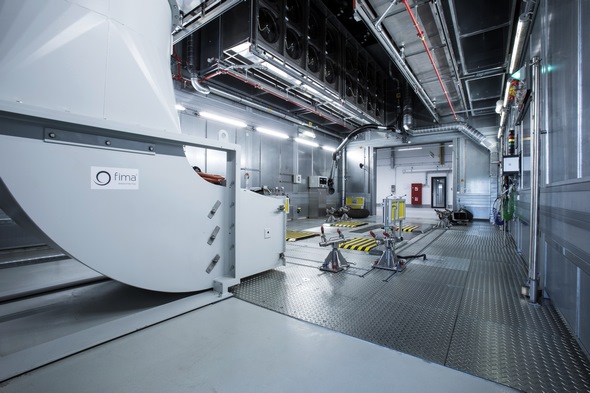
Stepped combustion bowl: A characteristic feature of the pistons of a direct-injection diesel engine is a recess (bowl) in the piston crown in which the injected fuel is swirled and mixed with air. If the bowl is stepped (instead of having the conventional omega shape), this has a number of advantages, such as excellent air utilisation with low particulate emissions and higher efficiency thanks to a higher burning rate. The changed flow conditions in the combustion chamber result in reduced heat loss across the cylinder wall as well as in a more uniform temperature distribution at the cylinder head and reduced loading on the highly stressed valve lands. The overall result is reduced wall heat loss, which likewise contributes to increased efficiency.
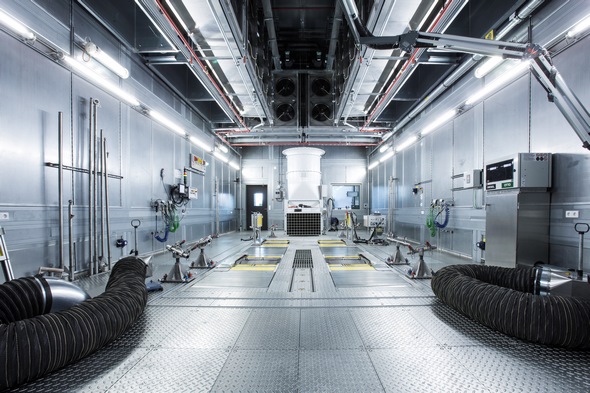
Twin-scroll turbochargers: These differ from other turbochargers because of the different design of the turbine housing. They represent an alternative to twin-turbo concepts with two parallel-arranged turbochargers. The spiral housing of the twin-scroll turbine is divided by a flow separator into two parallel flow channels. In combination with a two-pipe exhaust manifold, this allows the exhaust gases to be separately supplied to the turbine wheel. The goal is, if possible, to prevent negative cross-influencing of the individual cylinders during the charge cycle.
WLTP: New global test procedure (Worldwide harmonized Light vehicles Test Procedure) for measuring emissions and consumption. The definition of the new test is based on extensive real driving data from all regions of the world. The measurements are carried out in order to guarantee reproducibility and comparability under clearly defined conditions on the chassis dynamometer. The main difference between the new test cycle and the NEDC is its more dynamic driving profiles at higher speeds, a longer distance and test duration as well as vehicle-specific shift points. In addition, major changes result from modified test temperature parameters, inclusion of optional equipment, determination of driving resistances and vehicle test weights. The European Commission plans to introduce the WLTP in September 2017.
Landmarks in engine technology
Did you know that…
…NANOSLIDE® technology has already won several awards? In 2014-2015, for example, it won the European Business Award for the Environment in the “Processes” category. In 2015, it was awarded the “Oscar of Invention” by the US publication “R&D Magazine” and, in 2013, it won the “Golden Drop of Oil” awarded by the automobile club KRAFTFAHRER-SCHUTZ e.V. (KS). The developers of NANOSLIDE®, Dr.-Ing. Patrick Izquierdo (Daimler AG), Dipl.-Ing. Manuel Michel (Daimler AG) and Dipl.-Ing. (FH) Bernd Zapf (Gebr. Heller Maschinenfabrik GmbH), were recently nominated for the German Future Prize.
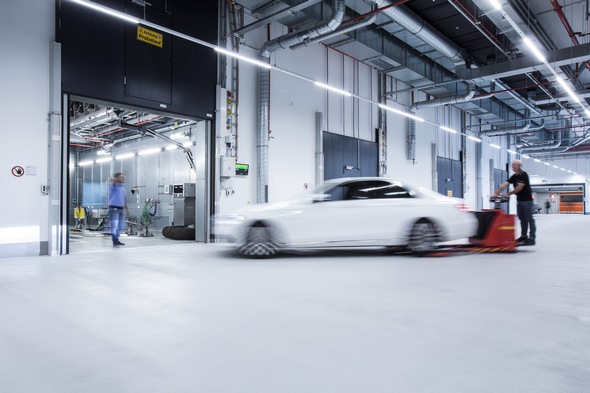
…in 1974, the 240 D 3.0 celebrated its world premiere as the first five-cylinder diesel engine in a standard-production passenger car? The same engine (OM 617) in the predecessor of the E-Class, the Stroke Eight, was also the very first five-cylinder engine in a passenger car. Its output: 59 kW (80 hp).
…the feedback-controlled three-way cat has now been available as standard from Mercedes-Benz for 30 years? This emission control system was brought out in autumn 1986 as standard equipment in all petrol-engined models.
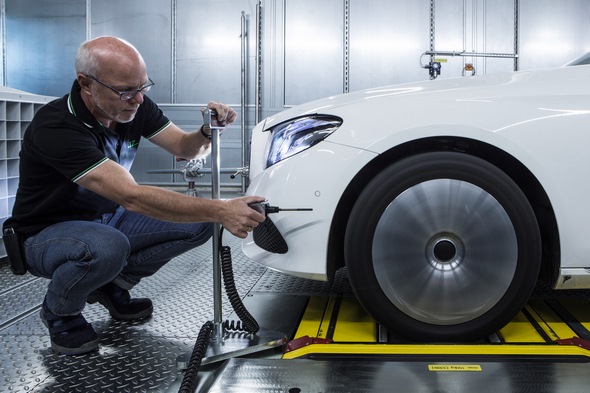
… ten years ago, the E 320 BlueTEC was the first diesel car to be approved for use in California? The model, which was equipped with an additional SCR catalyst, among other things, was launched in the USA in 2006 and came to Europe the following year. In 2007, the ML 320 BlueTEC, R 320 BlueTEC and GL 320 BlueTEC with AdBlue® injection were launched in the USA.
…three standard-production E 320 CDIs set a long-distance speed record of 224.823 km/h in 2005? On the circuit in Laredo, Texas, they covered a total of 100,000 miles (160,934 kilometres).
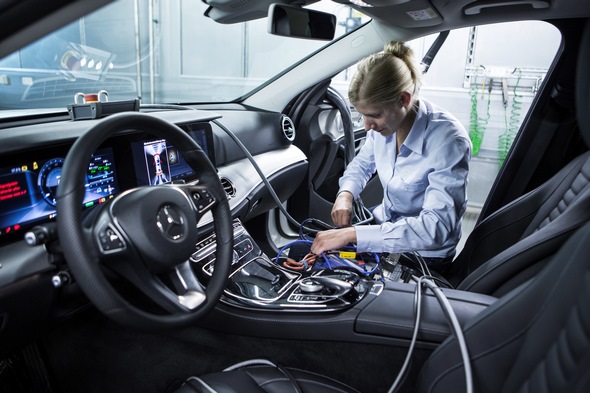
… in 1977, the 300 SD (W 116) was the first series-produced passenger car to be powered by a turbodiesel engine? This model, which was initially available only in North America, also ushered in the era of the diesel in the luxury class.
…in 2009, the S 400 HYBRID was the first luxury-class vehicle with a hybrid drive system and also the first standard-production passenger car with a lithium-ion battery?
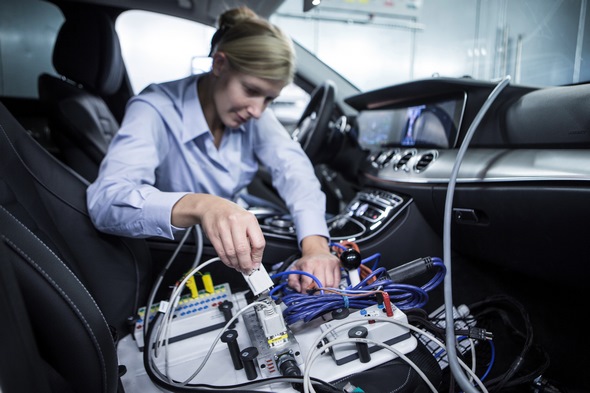
…the first C-Class generation (W 202) represented a landmark in diesel technology? This was the world’s first model series to feature four-valve technology in a diesel passenger car (1993, OM 604/605). It was followed in 1995 by the C 250 Turbodiesel, the first turbodiesel passenger car with four-valve technology and charge-air cooling. And, finally, in 1997 the C-Class was the first diesel engine with common-rail injection (C 220 CDI).
…the 260 D of 1936 was the world’s first standard-production diesel passenger car? Based on a truck engine, the four-cylinder machine OM 138 produced 33 kW (45 hp) from a displacement of 2.6 litres.
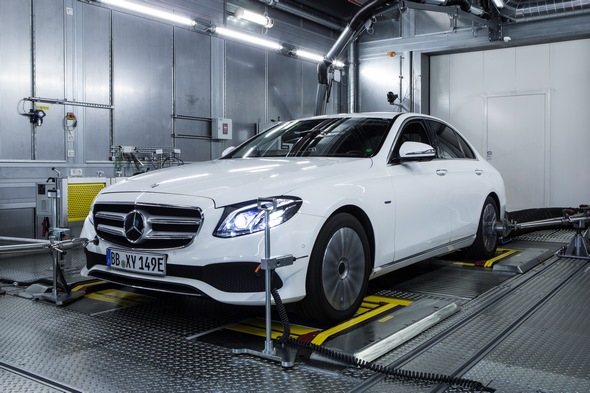
…in 1985, Mercedes-Benz was the world’s first automotive manufacturer to make diesel saloons in California optionally available with a particulate filter system?
…in 1886, independently of each other, Gottlieb Daimler and Carl Benz developed a petrol engine based on Nikolaus Otto’s four-stroke principle? Since being used in Benz’s patent motor car and in Daimler’s motor carriage, the four-stroke petrol engine has undergone unprecedented development as an automotive drive system.
…the era of the carburettor in Mercedes-Benz cars came to an end in 1990? The brand unveiled the 190 E 1.8 with a 1.8-litre injected engine at the Turin Motor Show in 1990. This was 36 years after petrol injection had made its debut in a four-stroke standard-production vehicle in the 300 SL.
…in 2002, with the CLK 200 CGI, Mercedes-Benz unveiled a revolutionary generation of directly injected petrol engines on the “Stratified Charged Gasoline Injection” (CGI) principle? The CGI process was taken to a new level in the CLS 350 CGI, which was presented in 2006: the four-door coupé was powered by the world’s first petrol engine with piezo direct injection and spray-guided combustion.
…the supercharged engine celebrated a comeback at Mercedes-Benz in 1995? The mechanical air compressor was first used in the 2.3-litre four-cylinder engines of the C-Class, SLK and CLK. Back in 1921, DMG (Daimler-Motoren-Gesellschaft) unveiled the world’s first supercharged passenger cars at the Berlin Motor Show.
…in 1983, the four-cylinder OM 601 in the Mercedes 190 (W 201) was nicknamed the “whispering diesel”? The machine in the 190 D (two-litre displacement, 53 kW/72 hp) was completely encapsulated, which halved the noise level.

